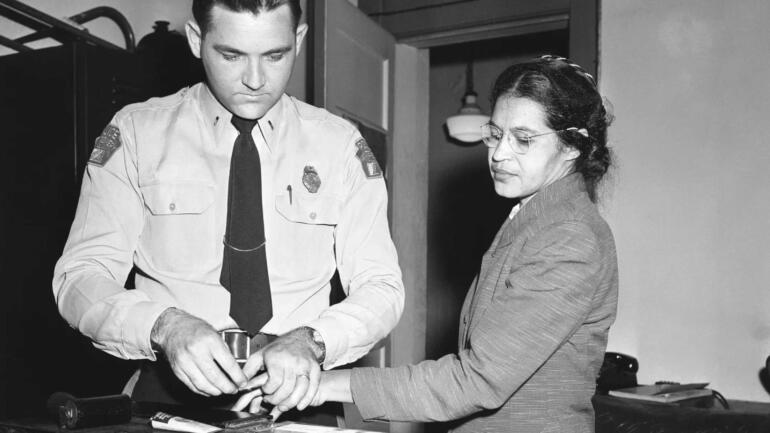Rosa Parks was arrested in Montgomery, Alabama for refusing to give up her bus seat to a white passenger on Dec. 1, 1955. However the photograph of her getting fingerprinted that has been widely circulated actually took place in 1956, when she was arrested a second time – one month into the Montgomery bus boycott that her first arrest ignited.
Parks and 88 others, including Martin Luther King, had voluntarily turned themselves in after city officials indicted them for violating a 1921 law prohibiting conspiracies interfering with business. The law was designed to break up trade union activity and outlawed boycotts against businesses without “just cause”.
The boycott lasted 381 days, and succeeded in aiding the end of legalized segregation in the U.S. and discrimination based on race, color, religion, sex, national origin, and later, sexual orientation and gender identity.

Diagram showing where Rosa Parks was seated on a Montgomery, Alabama, bus on December 1, 1955. At that time, the front 10 seats of the Montgomery city buses were permanently reserved for white passengers. Parks was seated in the first row behind those 10 seats. (National Archives)
Parks, who had been active in the NAACP for years before her arrest, became an icon of the civil rights movement. But immediately after the boycott, she faced threats and had trouble finding a job as a seamstress. She moved to Detroit in 1957 and worked for Rep. John Conyers from 1965-1988.
In her 1991 autobiography “My Story” Parks wrote: “All those laws against segregation have been passed, and all that progress has been made. But a whole lot of white people’s hearts have not been changed… What troubles me is that so many young people, including college students, have come out for white supremacy and that there have been more and more incidents of racism and racial violence on college campuses… It seems like we still have a long way to go.”
She died in 2005 at the age of 92. She was the first woman in U.S. history to lie in state at the U.S. Capitol.
The Police Officer

Drue Lackey, decades after the Montgomery bus boycott. (Breane Lyga, Youtube)
The man fingerprinting Parks was Officer Drue Lackey, who would later serve as the police chief for the Montgomery Police Department, retiring in 1970. He died in 2016.
His views on the Civil Rights Movement were largely unchanged throughout his life.
“People need to know the police officer’s side of the Civil Rights Movement… It was designed to intimidate and demoralize the police in the county and cause chaos in our cities and states,” Lackey wrote in his 2006 book “Another view of the civil rights movement”.
“There were many people fooled by Martin Luther King, Jr., and his so-called “non-violent movement”.
Not pictured: Claudette Colvin
While Rosa Parks became the face of civil disobedience against the Jim Crow laws, she was not the first person in Montgomery to challenge segregation.
When she was only 15 years old, Claudette Colvin refused to move seats for a white passenger and was arrested nine months before Parks.

Claudette Colvin in 2009. (AP Photo/Julie Jacobson)
Colvin said that she had just been studying black history in school. She refused to move, saying it was her “constitutional right”. She was dragged off the bus and endured racist and sexist name calling by police. The city charged her as an adult for breaking the segregation law, resisting arrest, and assaulting a police officer.
Immediately after her arrest, the NAACP aided Colvin’s defense. Parks, who was the organization’s secretary, played a big role in getting her legal help. Colvin became active in the NAACP youth council meetings and sometimes stayed at Parks’ apartment. Organizers had hoped Colvin’s case would be a good legal test of segregation. After her arrest, Colvin became pregnant by a married man and the NAACP felt she would not be an ideal candidate for the case.
Colvin’s actions spurred the Montgomery civil rights movement that led to the bus boycott after Parks’ arrest. Colvin’s arrest also helped activists prepare not resisting arrest, so that their sole charge would be violating the segregation law.
In 2005, she told a newspaper that she wasn’t disappointed that she never had the recognition that Parks got. “I’m not disappointed. Let the people know Rosa Parks was the right person for the boycott. But also let them know that the attorneys took four other women to the Supreme Court to challenge the law that led to the end of segregation.”
In 2021, Colvin applied to have her juvenile criminal record expunged. The judge agreed to expunge and destroy the records stating: “Her actions back in March of 1955 were conscientious, not criminal; inspired, not illegal; they should have led to praise and not prosecution”. The city of Montgomery has named March 2 as Claudette Colvin Day.
The Lawsuit
While Parks’ case led to the Montgomery boycott, lawyers from the NAACP knew that they couldn’t rely on the city changing policy. Ultimately they had to fight in court.
Attorney Fred Gray found plaintiffs for the case that would become Browder v. Gayle. Claudette Colvin and three other women, Aurelia Browder, Mary Louise Smith and Susie McDonald agreed to sue Montgomery Mayor William Gayle for the segregated bus system in federal court.
Rosa Parks was not included in the case for a technical reason. Gray wrote that since they were appealing her criminal case, he didn’t want to give the appearance that they were trying to circumvent her case. “I wanted the court to have only one issue to decide — the constitutionality of the laws requiring segregation on the buses in the city of Montgomery,” Gray wrote in his book “Bus Ride to Justice”.
On June 5, 1956, a three-judge panel ruled that the city’s bus rules were unconstitutional, citing as precedence the 1954 ruling of Brown vs. the Board of Education. The city appealed to the U.S. Supreme Court, which denied the appeal and ordered the city to desegregate buses. The boycott ended on December 20, 1956 a day before the city ended segregated buses.
Another iconic photo
On Dec. 21, 1956, a day after the Montgomery bus boycott ended, Rosa Parks boarded a bus and sat in what was once the white section to take this photograph. While the photo has been widely shared, few know that the white man sitting behind her is not a commuter, but a journalist. Nicholas C. Chriss was a reporter for United Press International and he had been asked by photographers from Look Magazine to sit behind Parks to dramatize the events. Author Douglas Brinkley who wrote a biography on Parks noted that it was a 100 percent staged event.
Chriss later reported for the Los Angeles Times and the Houston Chronicle. In 1986, he wrote about his experiences covering the civil rights movement. Of this photograph he wrote: “Each anniversary of that day, this photograph is brought out of musty files and used in various publications around the world. But to this day no one has ever made clear that it was a reporter, I, covering this event and sitting behind Mrs. Parks, not some sullen white segregationist! It was a great scoop for me, but Mrs. Parks had little to say. She seemed to want to savor the event alone.”
 CGTN America
CGTN America
 Rosa Parks getting fingerprinted in 1956, when she was arrested a second time – one month into the Montgomery bus boycott that her first arrest ignited. (Associated Press photo)
Rosa Parks getting fingerprinted in 1956, when she was arrested a second time – one month into the Montgomery bus boycott that her first arrest ignited. (Associated Press photo)
